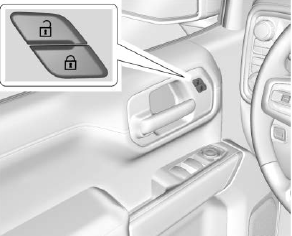Chevrolet Silverado: Wheels and Tires / Full-Size Spare Tire
If this vehicle came with a full-size spare tire, it was fully inflated when new, however, it can lose air over time. Check the inflation pressure regularly. See Tire Pressure and Vehicle Load Limits. For instructions on how to remove, install, or store a spare tire, see Tire Changing.
If equipped with a temporary use full-size spare tire, it is indicated on the tire sidewall. See Tire Sidewall Labeling. This spare tire should not be driven on over 112 km/h (70 mph), or 88 km/h (55 mph) when pulling a trailer, at the proper inflation pressure. Repair and replace the road tire as soon as it is convenient, and stow the spare tire for future use.
Caution
If the vehicle has four-wheel drive and a different size spare tire is installed, do not drive in four-wheel drive until the flat tire is repaired and/or replaced. The vehicle could be damaged and the repairs would not be covered by the warranty. Never use four-wheel drive when a different size spare tire is installed on the vehicle.
The vehicle may have a different size spare tire than the road tires originally installed on the vehicle. This spare tire was developed for use on this vehicle, so it is all right to drive on it. If the vehicle has four-wheel drive and a different size spare tire is installed, drive only in two-wheel drive.
After installing the spare tire on the vehicle, stop as soon as possible and check that the spare tire is correctly inflated.
Have the damaged or flat road tire repaired or replaced and installed back onto the vehicle as soon as possible so the spare tire will be available in case it is needed again.
Do not mix tires and wheels of different sizes, because they will not fit. Keep your spare tire and its wheel together. If the vehicle has a spare tire that does not match the original road tires and wheels in size and type, do not include the spare in the tire rotation.
 Tire Changing
Tire Changing
Removing the Spare Tire and Tools
Jack
Jack Knob
Tool Kit
Wing Nut Retaining Tool Kit
Wheel Blocks
Wing Nut Retaining Wheel Blocks
The equipment is under the second row seats, if equipped, or behind the front
row seats on regular cab models...
 Jump Starting
Jump Starting
Jump Starting - North America
For more information about the vehicle battery, see Battery - North America.
If the vehicle's battery (or batteries) has run down, you may want to use another
vehicle and some jumper cables to start your vehicle...
Other information:
Chevrolet Silverado 2019-2025 Owners Manual: Delayed Locking
If equipped, this feature delays the locking of the doors until five seconds after all doors are closed. Delayed locking can only be turned on when the Open Door Anti-Lockout feature has been turned off. When is pressed on the power door lock switch while the door is open, a chime will sound three times indicating delayed locking is active...
Chevrolet Silverado 2019-2025 Owners Manual: Introduction
Infotainment See the infotainment manual for information on the radio, audio players, phone, navigation system, and voice or speech recognition. It also includes information on settings. Active Noise Cancellation (ANC) If equipped, ANC reduces engine noise in the vehicle’s interior...
Categories
- Manuals Home
- 4th Generation Silverado Owners Manual
- 4th Generation Silverado Service Manual
- Head-Up Display (HUD)
- Engine Compartment Fuse Block
- Driver Information Center (DIC) (Base Level)
- New on site
- Most important about car
Power Door Locks

If equipped with power door locks.
 : Press to lock the doors.
: Press to lock the doors.
